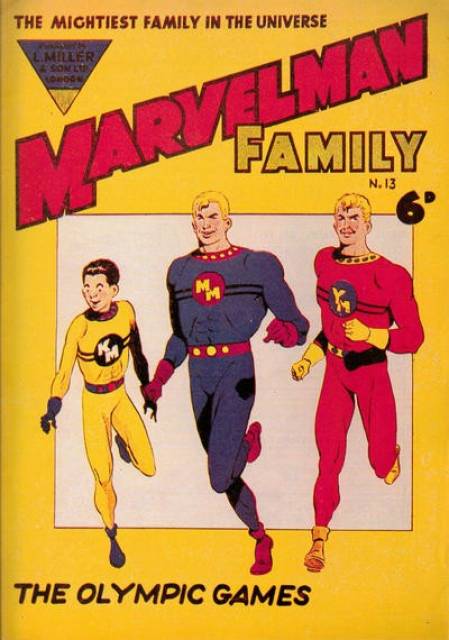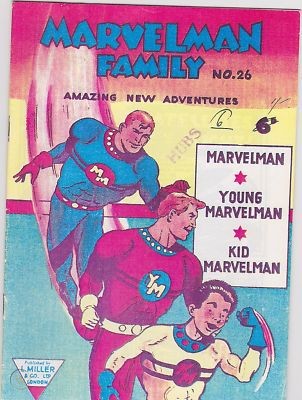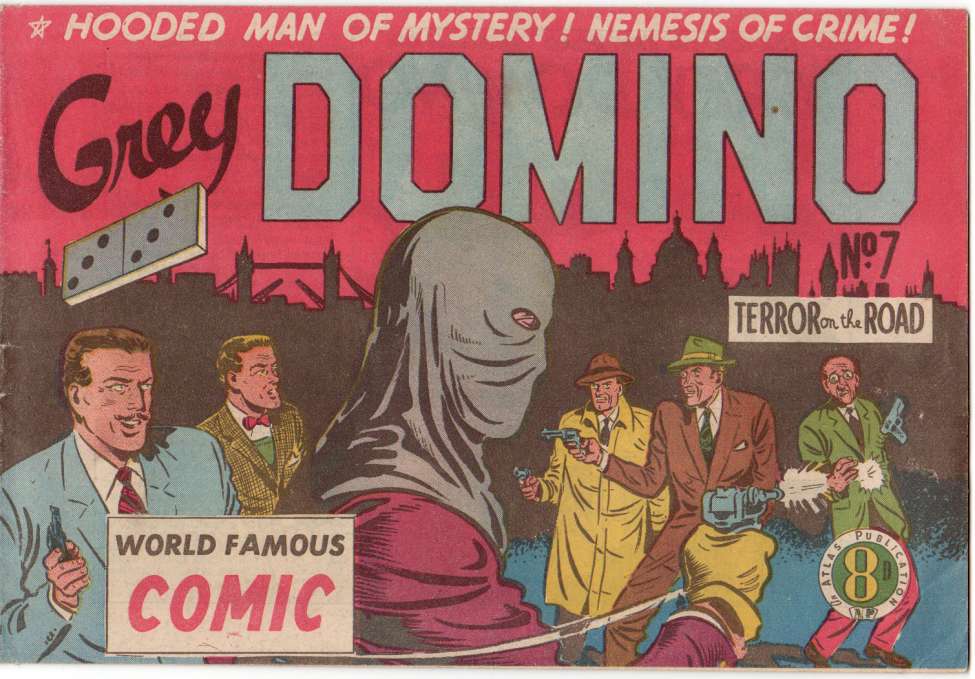Superheroes Published between 1951 and 1956 - Dead space between Golden Age and Silver Age
The Vanguard Play by Post Roleplaying Game :: The Vanguard and Ultrahumans! :: OOC (Out of character chat)
Page 1 of 1
 Superheroes Published between 1951 and 1956 - Dead space between Golden Age and Silver Age
Superheroes Published between 1951 and 1956 - Dead space between Golden Age and Silver Age
Since I presented an idea of having a storyline of superheroes during this short period of Superheroes that came between the end of the Golden Age, which most say ended in 1950, and the beginning of the Silver Age with the appearance of the 2nd Flash in Showcase Comics in late 1956, I thought I would find which superheroes were published in that five year period of time. Wonder Woman, Batman and Superman were continuously published and are about the only superheroes to stay mostly the same from Golden Age to Silver Age.
Here's what I found so far:
Doll Man 1953 ended
Plastic Man 1956 ended
First Appearances
Captain Comet 1951 (June) DC John Broome, Carmine Infantino Strange Adventures #9
Doll Girl 1951 (December) Quality Comics Will Eisner Doll Man #37
Phantom Stranger 1952 (August) DC John Broome, Carmine Infantino, Sy Barry Phantom Stranger #1
Marvelman (later Miracleman) 1954 (February) [U.K.] Mick Anglo Marvelman #25
Fighting American 1954 (April) Prize Group Joe Simon & Jack Kirby Fighting American #1
Captain Flash 1954 (November) Mike Sekowsky (artist, writer unknown) Captain Flash #1
Martian Manhunter 1955 (November) DC Joseph Samachson, Joe Certa Detective Comics #225
Batwoman (Kathy Kane, 1st ver) 1956 (July) DC Edmond Hamilton, Sheldon Moldoff Detective Comics #233
Flash {Barry Allen} cover date Oct, 1956 - considered the start of the Silver Age
Timely made one more attempt at superheroes with the publication of Marvel Boy #1-2 (Dec. 1950 - Feb. 1951), which was retitled Astonishing with issue #3 (April 1951) and continued the Marvel Boy feature through #6 (Oct. 1951).
Atlas attempted to revive superheroes in Young Men #24-28 (Dec. 1953 - June 1954) with the Human Torch (art by Syd Shores and Dick Ayers, variously), the Sub-Mariner (drawn and most stories written by Bill Everett) and Captain America (writer Stan Lee, artist John Romita Sr.). The short-lived revival also included restarts of Sub-Mariner Comics (issues #33-42, April 1954 - Oct. 1955)[13] and Captain America (#76-78, May-Sept. 1954).[14] All three superheroes also appeared in the final two issues of Men's Adventures (#27-28, May–July 1954).[
Alfred Harvey’s company endured into the 1990s, but this era of costumed heroes ended in 1951. Kit. Kit Weston, circus acrobat, is orphaned when his family’s circus is the victim of arson. He then becomes the youthful male sidekick of the Black Cat. Black Cat is a comic book adventure heroine published by Harvey Comics from 1941 to 1951. Harvey also published reprints of the character in both the mid-1950s and the early 1960s
The Vigilante (DC) Greg Saunders first appeared in Action Comics #42 (November 1941). He appeared in every issue of Action Comics until #198 (Nov 1954)
The Shining Knight - last appearance was Adventure Comics 188 July, 1951. Wouldn't reappear again until a JLA story in 1972.
Johnny Quick is a Golden Age DC Comics character with the power of superhuman speed. The character first appeared in More Fun Comics #71 (September 1941).[1] After his More Fun run ended in issue #107 (January-February 1946), he was moved to Adventure Comics with issue #103 (April 1946). He remained as a regular feature in Adventure until issue #207 (December 1954)
Green Arrow and Aquaman survived the Golden Age as back-up features in various comics before becoming members of the JLA.
Nature Boy is a superhero created by Jerry Siegel and drawn by John Buscema and others. He first appeared in Nature Boy #3 (March 1956), published by Charlton Comics.
Blue Beetle In the mid-1950s, Fox Comics went out of business and sold the rights to the Blue Beetle to Charlton Comics. That company published a few sporadic adventures of the Golden Age character before revamping the hero in 1964.
Zaza the Mystic is a fictional character that appeared in comic books published by Charlton Comics. She appeared in only two issues, Zaza the Mystic #10 (April 1956) and Zaza the Mystic #11 (September 1956). Zaza was introduced in Zaza the Mystic #10 as a gypsy fortuneteller with the ability to accurately tell the future.
Mr. Muscles #22 (March 1956) - 1st appearance
Strong Man (1955) comic books 1-4
The Avenger #1 (February-March 1955) 4 issues
Bulletman and Bulletigirl Fawcett Comics (1939–1953)
Captain Marvel, Captain Marvel Jr, Mary Marvel Whiz Comics had ended with issue #155 in June 1953, Captain Marvel Adventures was canceled with #150 in November 1953, and The Marvel Family ended its run with #89 in January 1954.
Ibis the Invincible Fawcett Comics (1942 - 1953) Charlton Comics (1955)
Phantom Lady (4 issues, 1954–1955) — originally published by Quality Comics, Fox Features Syndicate, and Star Publications; this is Ajax version
Samson (3 issues, 1955) — originally published by Fox Features Syndicate; this is Ajax version
Wonder Boy (2 issues, 1955) — originally published by Quality Comics; this is Ajax version
Air Fighters Comics Renamed Airboy Comics with the twenty-third issue, vol. 2, #11 (Dec. 1945), and ran 89 issues, through vol. 10, #4 (May 1953)
Crimebuster Boy Comics (1942–1956) 117 issues, he dropped the name Crimebuster when he went off to technical college and the last few years he was just plain ole Chuck Chandler, still solving crimes though
I think that is pretty much it. There might be one or two more out there from American comics. Have no idea about Canadian, Australian or English superheroes for those 5 years.
Here's what I found so far:
Doll Man 1953 ended
Plastic Man 1956 ended
First Appearances
Captain Comet 1951 (June) DC John Broome, Carmine Infantino Strange Adventures #9
Doll Girl 1951 (December) Quality Comics Will Eisner Doll Man #37
Phantom Stranger 1952 (August) DC John Broome, Carmine Infantino, Sy Barry Phantom Stranger #1
Marvelman (later Miracleman) 1954 (February) [U.K.] Mick Anglo Marvelman #25
Fighting American 1954 (April) Prize Group Joe Simon & Jack Kirby Fighting American #1
Captain Flash 1954 (November) Mike Sekowsky (artist, writer unknown) Captain Flash #1
Martian Manhunter 1955 (November) DC Joseph Samachson, Joe Certa Detective Comics #225
Batwoman (Kathy Kane, 1st ver) 1956 (July) DC Edmond Hamilton, Sheldon Moldoff Detective Comics #233
Flash {Barry Allen} cover date Oct, 1956 - considered the start of the Silver Age
Timely made one more attempt at superheroes with the publication of Marvel Boy #1-2 (Dec. 1950 - Feb. 1951), which was retitled Astonishing with issue #3 (April 1951) and continued the Marvel Boy feature through #6 (Oct. 1951).
Atlas attempted to revive superheroes in Young Men #24-28 (Dec. 1953 - June 1954) with the Human Torch (art by Syd Shores and Dick Ayers, variously), the Sub-Mariner (drawn and most stories written by Bill Everett) and Captain America (writer Stan Lee, artist John Romita Sr.). The short-lived revival also included restarts of Sub-Mariner Comics (issues #33-42, April 1954 - Oct. 1955)[13] and Captain America (#76-78, May-Sept. 1954).[14] All three superheroes also appeared in the final two issues of Men's Adventures (#27-28, May–July 1954).[
Alfred Harvey’s company endured into the 1990s, but this era of costumed heroes ended in 1951. Kit. Kit Weston, circus acrobat, is orphaned when his family’s circus is the victim of arson. He then becomes the youthful male sidekick of the Black Cat. Black Cat is a comic book adventure heroine published by Harvey Comics from 1941 to 1951. Harvey also published reprints of the character in both the mid-1950s and the early 1960s
The Vigilante (DC) Greg Saunders first appeared in Action Comics #42 (November 1941). He appeared in every issue of Action Comics until #198 (Nov 1954)
The Shining Knight - last appearance was Adventure Comics 188 July, 1951. Wouldn't reappear again until a JLA story in 1972.
Johnny Quick is a Golden Age DC Comics character with the power of superhuman speed. The character first appeared in More Fun Comics #71 (September 1941).[1] After his More Fun run ended in issue #107 (January-February 1946), he was moved to Adventure Comics with issue #103 (April 1946). He remained as a regular feature in Adventure until issue #207 (December 1954)
Green Arrow and Aquaman survived the Golden Age as back-up features in various comics before becoming members of the JLA.
Nature Boy is a superhero created by Jerry Siegel and drawn by John Buscema and others. He first appeared in Nature Boy #3 (March 1956), published by Charlton Comics.
Blue Beetle In the mid-1950s, Fox Comics went out of business and sold the rights to the Blue Beetle to Charlton Comics. That company published a few sporadic adventures of the Golden Age character before revamping the hero in 1964.
Zaza the Mystic is a fictional character that appeared in comic books published by Charlton Comics. She appeared in only two issues, Zaza the Mystic #10 (April 1956) and Zaza the Mystic #11 (September 1956). Zaza was introduced in Zaza the Mystic #10 as a gypsy fortuneteller with the ability to accurately tell the future.
Mr. Muscles #22 (March 1956) - 1st appearance
Strong Man (1955) comic books 1-4
The Avenger #1 (February-March 1955) 4 issues
Bulletman and Bulletigirl Fawcett Comics (1939–1953)
Captain Marvel, Captain Marvel Jr, Mary Marvel Whiz Comics had ended with issue #155 in June 1953, Captain Marvel Adventures was canceled with #150 in November 1953, and The Marvel Family ended its run with #89 in January 1954.
Ibis the Invincible Fawcett Comics (1942 - 1953) Charlton Comics (1955)
Phantom Lady (4 issues, 1954–1955) — originally published by Quality Comics, Fox Features Syndicate, and Star Publications; this is Ajax version
Samson (3 issues, 1955) — originally published by Fox Features Syndicate; this is Ajax version
Wonder Boy (2 issues, 1955) — originally published by Quality Comics; this is Ajax version
Air Fighters Comics Renamed Airboy Comics with the twenty-third issue, vol. 2, #11 (Dec. 1945), and ran 89 issues, through vol. 10, #4 (May 1953)
Crimebuster Boy Comics (1942–1956) 117 issues, he dropped the name Crimebuster when he went off to technical college and the last few years he was just plain ole Chuck Chandler, still solving crimes though
I think that is pretty much it. There might be one or two more out there from American comics. Have no idea about Canadian, Australian or English superheroes for those 5 years.
Last edited by DavidMcMahon on Fri Aug 07 2020, 12:03; edited 1 time in total

DavidMcMahon- Cosmic Level
- Posts : 8754
Join date : 2010-05-10
Age : 64
Location : Raleigh, NC, USA
 Re: Superheroes Published between 1951 and 1956 - Dead space between Golden Age and Silver Age
Re: Superheroes Published between 1951 and 1956 - Dead space between Golden Age and Silver Age
Australia managed to hang on to a few superheroes in the 1950s.
Between 1949 and 1958 Frew also published comics including Popeye, The Phantom Ranger, The Shadow (an Australian creation not to be confused with the American version of The Shadow), Sir Falcon, Catman and Super Yank Comics, peaking to a total of thirty titles in the mid 1950s.
The Shadow

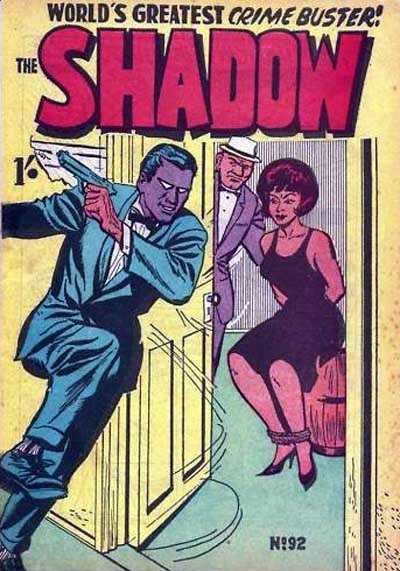
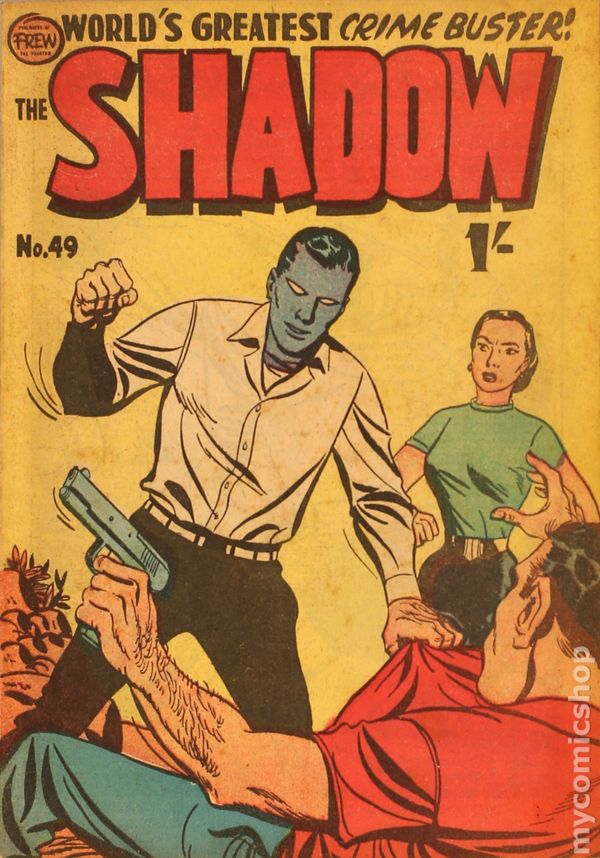

However unknown to anyone Jimmy was really leading a triple life, the one everyone knew as Jimmy Gray playboy millionaire, but also secretly as Limpy Olsen former second story man who had to cut back on his thievery due, so he said, to his having broken his leg while trying to break into a house to rob, but still a well known and liked member of the criminal underworld, and after donning either a tux or white dinner jacket, and a pair of black gloves and a black latex rubber mask, The Shadow, the World’s Greatest Crime Buster.
Hunted by both the police and the underworld he used the information he gathered as Limpy, and using the resources he had as Jimmy The Shadow was able to become an effective instrument of justice.
skills
Escape Artist
Insanely Rich
Marksmanship
Stealth
Unarmed Combat
Between 1949 and 1958 Frew also published comics including Popeye, The Phantom Ranger, The Shadow (an Australian creation not to be confused with the American version of The Shadow), Sir Falcon, Catman and Super Yank Comics, peaking to a total of thirty titles in the mid 1950s.
The Shadow



Origin
After Jimmy Gray inherited the vast fortune of his father, safe manufacturer “silver” Gray people were disappointed when he devoted himself proving himself to be the most useless playboy in Australia.
However unknown to anyone Jimmy was really leading a triple life, the one everyone knew as Jimmy Gray playboy millionaire, but also secretly as Limpy Olsen former second story man who had to cut back on his thievery due, so he said, to his having broken his leg while trying to break into a house to rob, but still a well known and liked member of the criminal underworld, and after donning either a tux or white dinner jacket, and a pair of black gloves and a black latex rubber mask, The Shadow, the World’s Greatest Crime Buster.
Hunted by both the police and the underworld he used the information he gathered as Limpy, and using the resources he had as Jimmy The Shadow was able to become an effective instrument of justice.
skills
Escape Artist
Insanely Rich
Marksmanship
Stealth
Unarmed Combat
Last edited by DavidMcMahon on Fri Jul 17 2020, 14:40; edited 2 times in total

DavidMcMahon- Cosmic Level
- Posts : 8754
Join date : 2010-05-10
Age : 64
Location : Raleigh, NC, USA

DavidMcMahon- Cosmic Level
- Posts : 8754
Join date : 2010-05-10
Age : 64
Location : Raleigh, NC, USA
 Re: Superheroes Published between 1951 and 1956 - Dead space between Golden Age and Silver Age
Re: Superheroes Published between 1951 and 1956 - Dead space between Golden Age and Silver Age
Catman and his sidekick Kit, made his Australian debut in the pages of Super Yank Comics (19 issues/1951-1952), a new comic from Frew Publications, who also published the Australian edition of The Phantom.


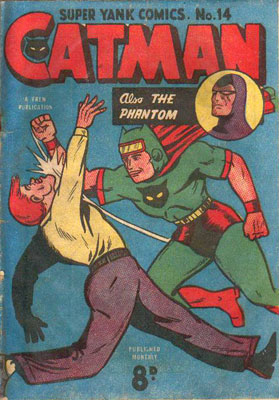




DavidMcMahon- Cosmic Level
- Posts : 8754
Join date : 2010-05-10
Age : 64
Location : Raleigh, NC, USA
 Re: Superheroes Published between 1951 and 1956 - Dead space between Golden Age and Silver Age
Re: Superheroes Published between 1951 and 1956 - Dead space between Golden Age and Silver Age
Sir Falcon - Australia
The first issue of Sir Falcon was published in August 1954. It ran for 44 issues until August 1958. The publication was then taken over by Tricho Publications, who published a further eleven issues until May 1963.
Sir Falcon was based on a similar premise to the Phantom, with an inherited costumed identity giving rise to public belief that the character is immortal however in this case the individual is a modern-day Arthurian Knight. His civilian identity is known as Mr Knight.
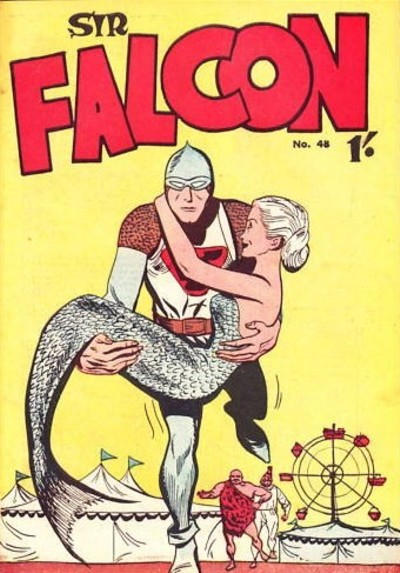
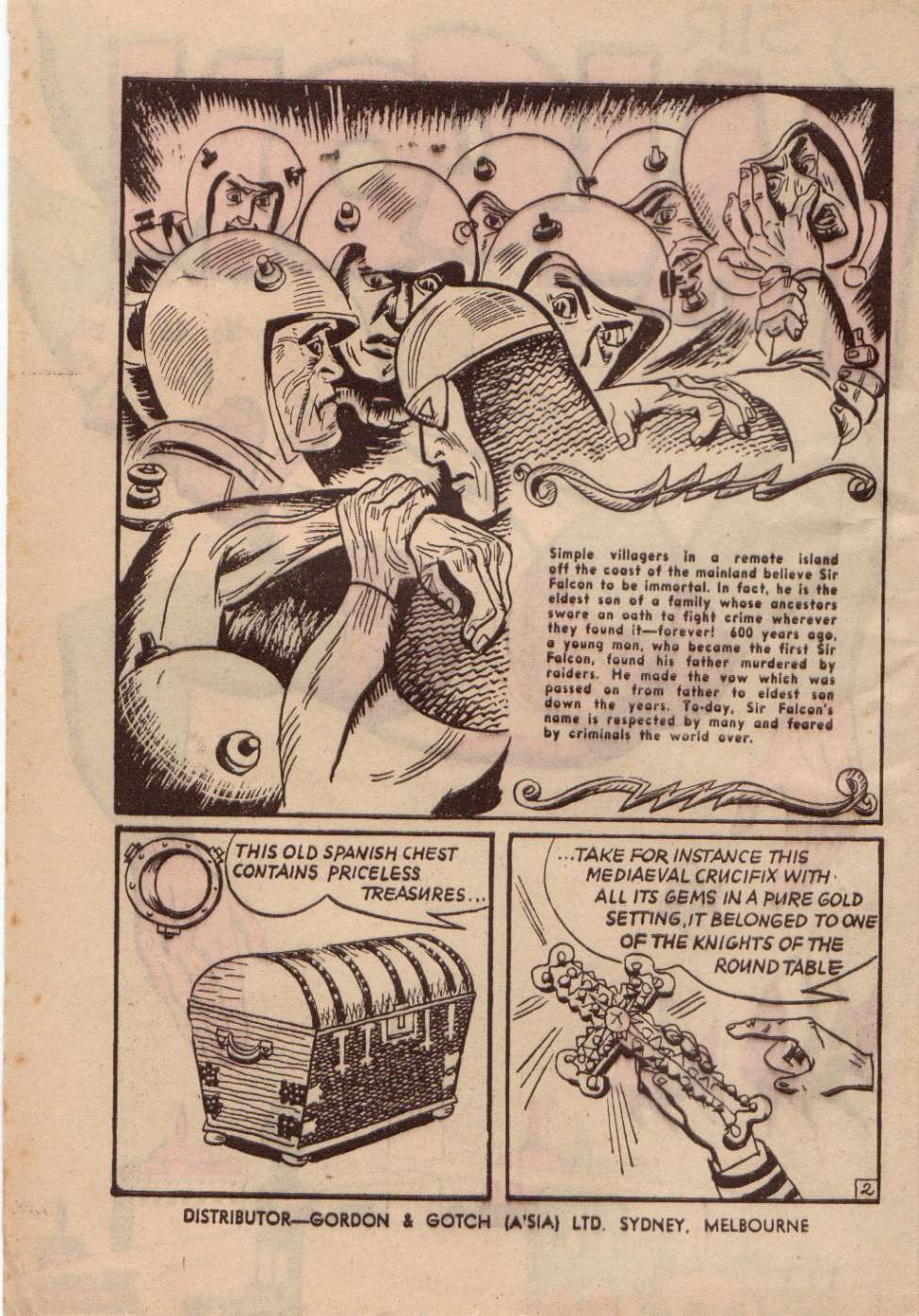
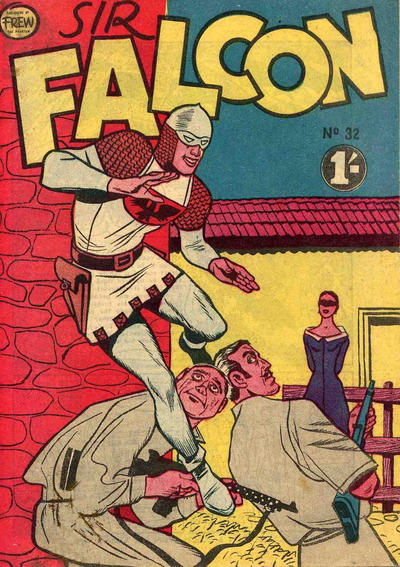
The first issue of Sir Falcon was published in August 1954. It ran for 44 issues until August 1958. The publication was then taken over by Tricho Publications, who published a further eleven issues until May 1963.
Sir Falcon was based on a similar premise to the Phantom, with an inherited costumed identity giving rise to public belief that the character is immortal however in this case the individual is a modern-day Arthurian Knight. His civilian identity is known as Mr Knight.




DavidMcMahon- Cosmic Level
- Posts : 8754
Join date : 2010-05-10
Age : 64
Location : Raleigh, NC, USA
 Re: Superheroes Published between 1951 and 1956 - Dead space between Golden Age and Silver Age
Re: Superheroes Published between 1951 and 1956 - Dead space between Golden Age and Silver Age
Wow! More Australian heroes in the 1950s than I thought!
Captain Atom is an Australian comic book series created and written by Jack Bellew with illustrations by Arthur Mather.[1] It was published from 1948 to 1954, with 64 issues[2] and it also appeared as strips in a number of Australian newspapers. The protagonist, the first to use the name, has no relation to the later American superhero Captain Atom,[3] published by Charlton Comics in 1965[4] and subsequently by DC Comics in 1987.[5]
The character is based on a combination of Fawcett Publications' Captain Marvel and Quality Comics' Captain Triumph (first published in 1941 and 1943 respectively).[sup][7][8][/sup]
The character's origin had identical twin brothers being caught in an atomic bomb blast and becoming fused into one, with Dr. Bikini Rador (a nuclear physicist) being the dominant persona. By shouting the magic word, Exenor!, Rador transforms into his now atomic-powered twin. Rador takes on the identity of Larry Lockhart, an FBI agent, to fight crime, switching places with his brother when situations call for a superhero.[3][9]
The comic was originally published entirely in colour, but Atlas followed its chief rival, K.G. Murray, and switched to black and white two years later when the cost of colour printing became prohibitive. Despite the switch to black and white, the Captain Atom series remained successful, running to 64 issues over the next six years.[10][11][12][13] The first issue of Captain Atom, which was released in January 1948[14] sold approximately 100,000 copies[15] and at its peak was selling 180,000 copies.[3][16] Early issues featured backup stories provided by Mather (Dopey Dan), Stan Pitt (Jim Atlas, Dr Peril of Igogo) and Michael Trueman (Crackajack – Daredevil Trapeze Star).[7]
Captain Atom was one of the few original Australian comic heroes to have his own merchandising and fan club. In the 1950s the fan club boasted that it had "over 75,000 members".[3][7]

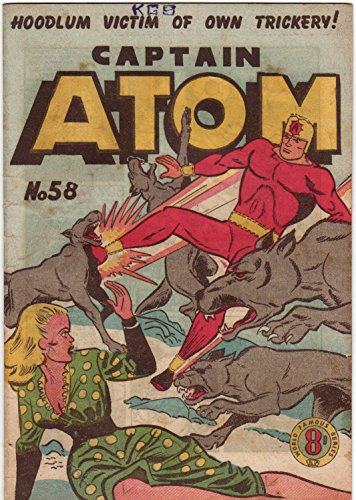
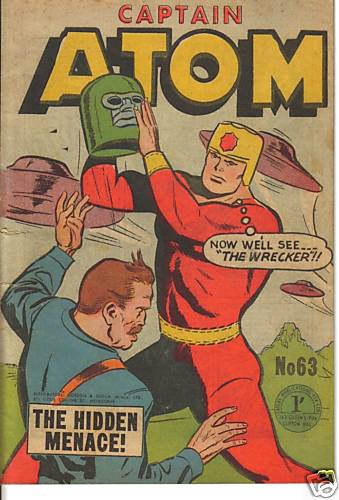
Captain Atom is an Australian comic book series created and written by Jack Bellew with illustrations by Arthur Mather.[1] It was published from 1948 to 1954, with 64 issues[2] and it also appeared as strips in a number of Australian newspapers. The protagonist, the first to use the name, has no relation to the later American superhero Captain Atom,[3] published by Charlton Comics in 1965[4] and subsequently by DC Comics in 1987.[5]
The character is based on a combination of Fawcett Publications' Captain Marvel and Quality Comics' Captain Triumph (first published in 1941 and 1943 respectively).[sup][7][8][/sup]
The character's origin had identical twin brothers being caught in an atomic bomb blast and becoming fused into one, with Dr. Bikini Rador (a nuclear physicist) being the dominant persona. By shouting the magic word, Exenor!, Rador transforms into his now atomic-powered twin. Rador takes on the identity of Larry Lockhart, an FBI agent, to fight crime, switching places with his brother when situations call for a superhero.[3][9]
The comic was originally published entirely in colour, but Atlas followed its chief rival, K.G. Murray, and switched to black and white two years later when the cost of colour printing became prohibitive. Despite the switch to black and white, the Captain Atom series remained successful, running to 64 issues over the next six years.[10][11][12][13] The first issue of Captain Atom, which was released in January 1948[14] sold approximately 100,000 copies[15] and at its peak was selling 180,000 copies.[3][16] Early issues featured backup stories provided by Mather (Dopey Dan), Stan Pitt (Jim Atlas, Dr Peril of Igogo) and Michael Trueman (Crackajack – Daredevil Trapeze Star).[7]
Captain Atom was one of the few original Australian comic heroes to have his own merchandising and fan club. In the 1950s the fan club boasted that it had "over 75,000 members".[3][7]



| Captain Atom #1 (January 1948) |
| Jack Bellew (writer) Arthur Mather (artist) |
| Dr Bikini Rador (aka Larry Lockhart) |
| The Atomic Warrior, the Atom Man, Atoman |
|

DavidMcMahon- Cosmic Level
- Posts : 8754
Join date : 2010-05-10
Age : 64
Location : Raleigh, NC, USA
 Re: Superheroes Published between 1951 and 1956 - Dead space between Golden Age and Silver Age
Re: Superheroes Published between 1951 and 1956 - Dead space between Golden Age and Silver Age
http://www.internationalhero.co.uk/c/cappower.htm
Captain Power - a newspaper strip, not a comic book from Australia. It lasted until at least 1952
Captain Power written by Gerry Brown illustrated by Stanley Pitt. Captain Power's creators borrowed freely from Rip Kirby, Flash Gordon and Superman. Power could do anything Superman could do, he had super strength, a jet pack for flying and x-ray goggles. His sidekick sported the worst nickname ever: Atommy. The atomic bomb tests on Bikini Atoll in 1946 made a huge impression on Australian cartoonists. The first strip appeared March 6, 1949. Captain Power got married, his wife got the same set of powers and was called Lynn the Atom-Girl and the three formed the Atomic Trio.
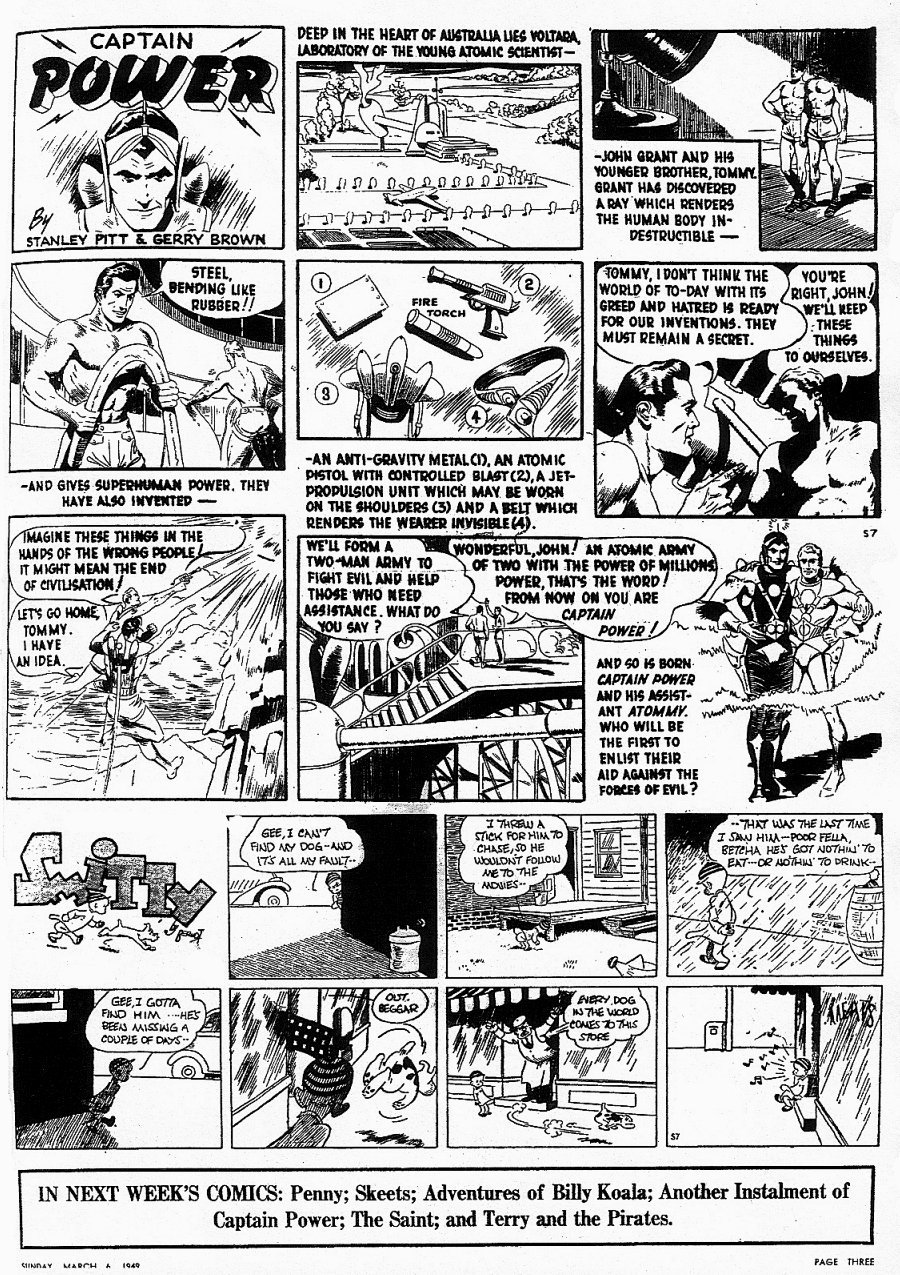
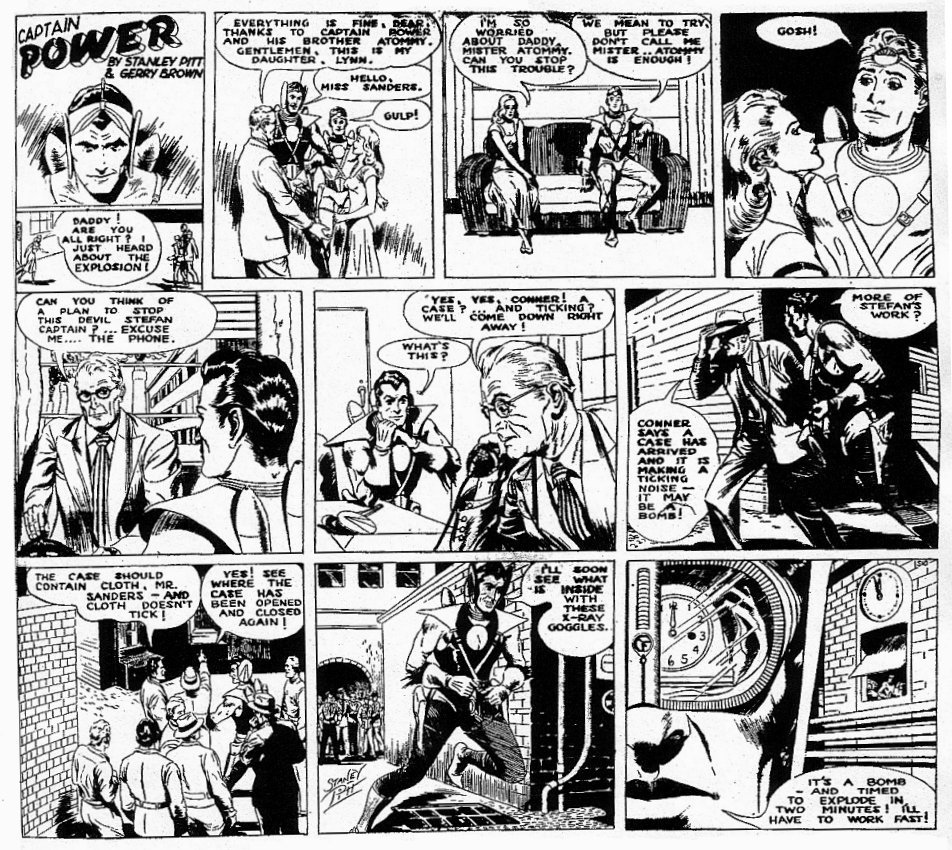
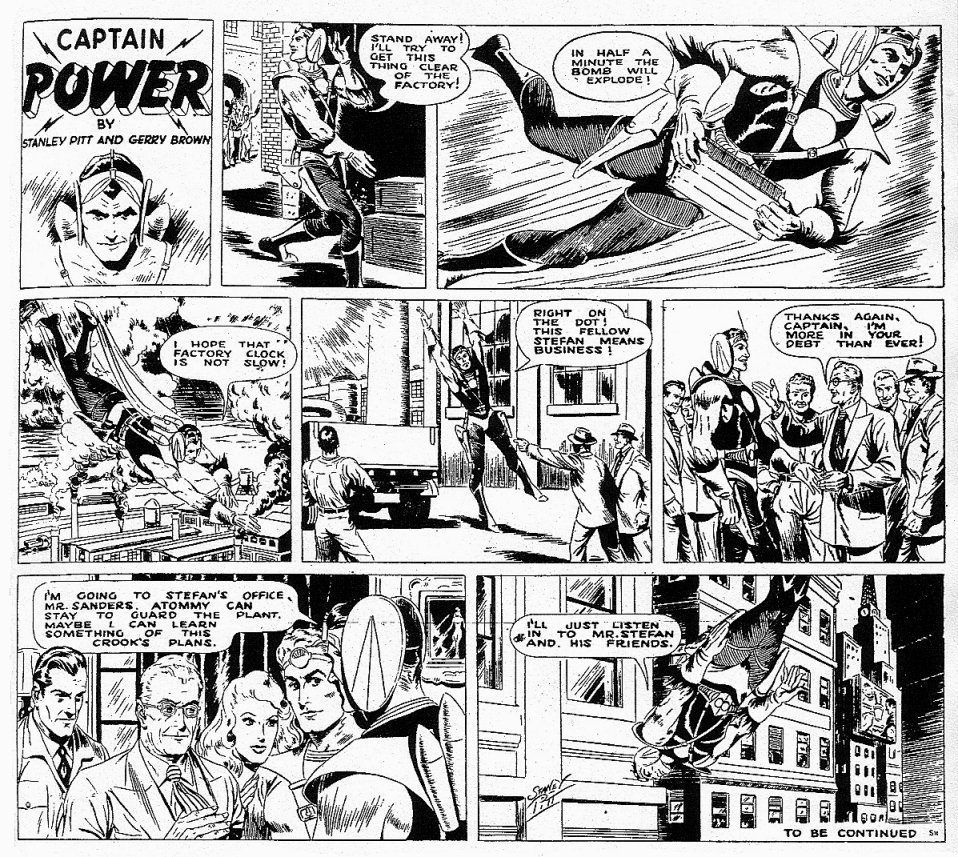
Captain Power - a newspaper strip, not a comic book from Australia. It lasted until at least 1952
Captain Power written by Gerry Brown illustrated by Stanley Pitt. Captain Power's creators borrowed freely from Rip Kirby, Flash Gordon and Superman. Power could do anything Superman could do, he had super strength, a jet pack for flying and x-ray goggles. His sidekick sported the worst nickname ever: Atommy. The atomic bomb tests on Bikini Atoll in 1946 made a huge impression on Australian cartoonists. The first strip appeared March 6, 1949. Captain Power got married, his wife got the same set of powers and was called Lynn the Atom-Girl and the three formed the Atomic Trio.




DavidMcMahon- Cosmic Level
- Posts : 8754
Join date : 2010-05-10
Age : 64
Location : Raleigh, NC, USA
 Re: Superheroes Published between 1951 and 1956 - Dead space between Golden Age and Silver Age
Re: Superheroes Published between 1951 and 1956 - Dead space between Golden Age and Silver Age
Char Chapman - Australia
Published in Australia, Char Chapman: The Phantom of the East started as a secondary character in other Australian comics in 1948 and by 53’ had become popular enough to get his own comic, Char is two-fisted adventurer who started out during the Malay Incident and then was shown going from jungle to jungle knocking heads together for the Commonwealth.
Great Strength and Agility and Senses honed from his time living in the jungles.
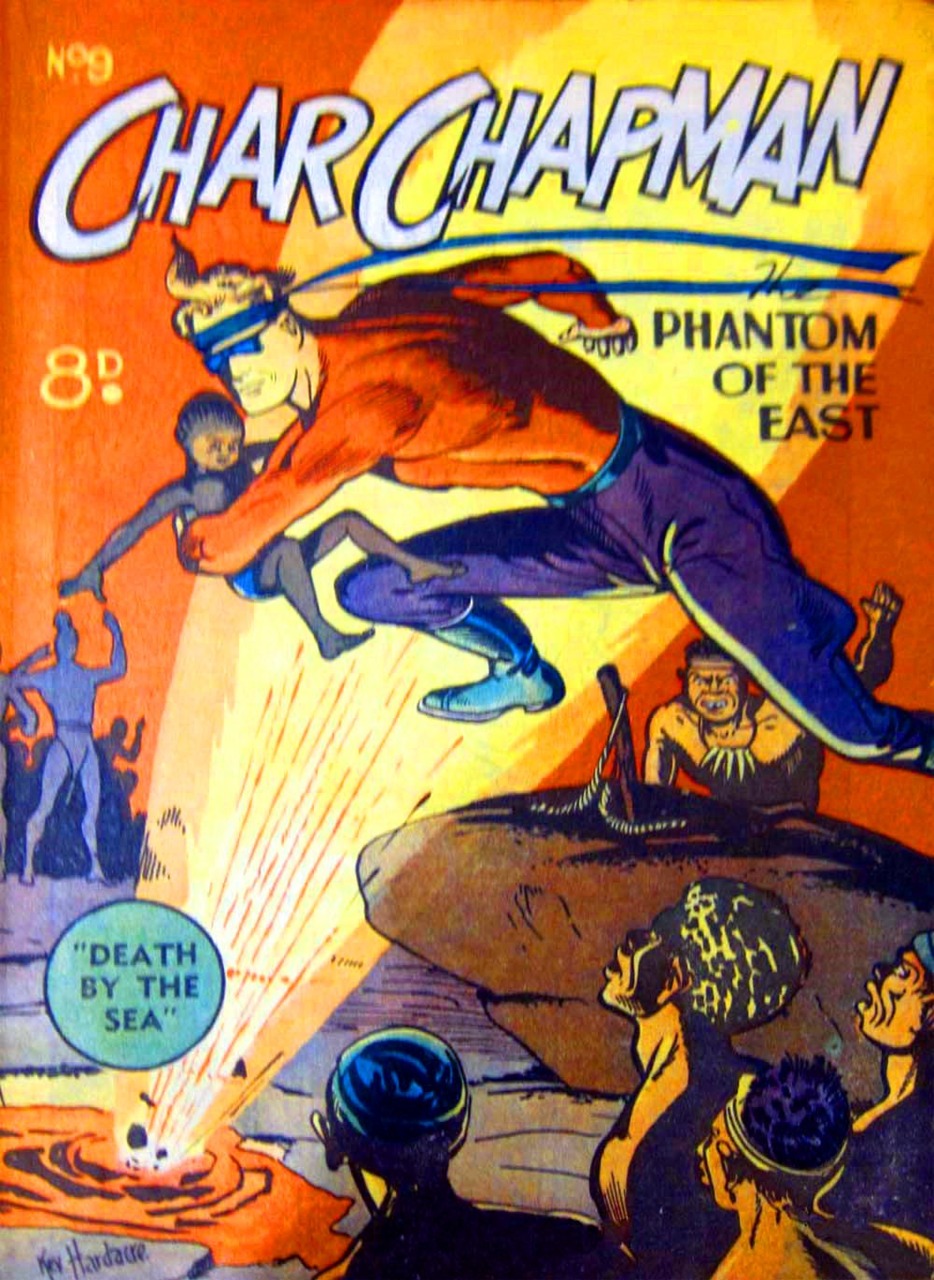
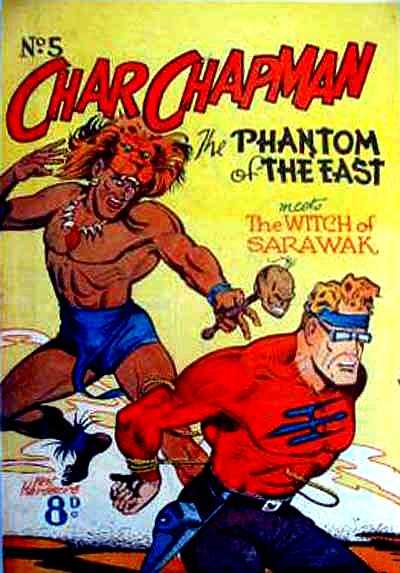

Published in Australia, Char Chapman: The Phantom of the East started as a secondary character in other Australian comics in 1948 and by 53’ had become popular enough to get his own comic, Char is two-fisted adventurer who started out during the Malay Incident and then was shown going from jungle to jungle knocking heads together for the Commonwealth.
Great Strength and Agility and Senses honed from his time living in the jungles.




DavidMcMahon- Cosmic Level
- Posts : 8754
Join date : 2010-05-10
Age : 64
Location : Raleigh, NC, USA

DavidMcMahon- Cosmic Level
- Posts : 8754
Join date : 2010-05-10
Age : 64
Location : Raleigh, NC, USA
 Re: Superheroes Published between 1951 and 1956 - Dead space between Golden Age and Silver Age
Re: Superheroes Published between 1951 and 1956 - Dead space between Golden Age and Silver Age
Jet Fury - http://www.internationalhero.co.uk/j/jetfury.htm
"For Pyramid, Horak created a costumed hero, Jet Fury, who looked like his Skyman character. Jet Fury had originally appeared as a back-up feature in Michael Chance Comics, but soon took over the title and the numbering sequence" -- Ryan, John. Panel by panel. Stanmore, N.S.W. : Cassell Australia, 1979. Page 196.
Publication Dates: 1950 - 1952 Number of Issues Published: 13 (#17 - #29) Color: Colour Cover; Black and White Interior Dimensions: 7.25 " by 10.75" Paper Stock: Newsprint
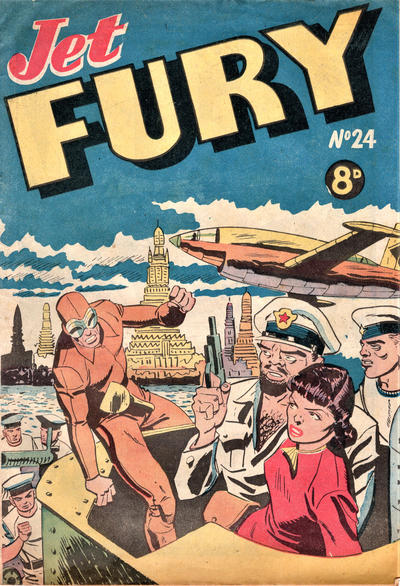
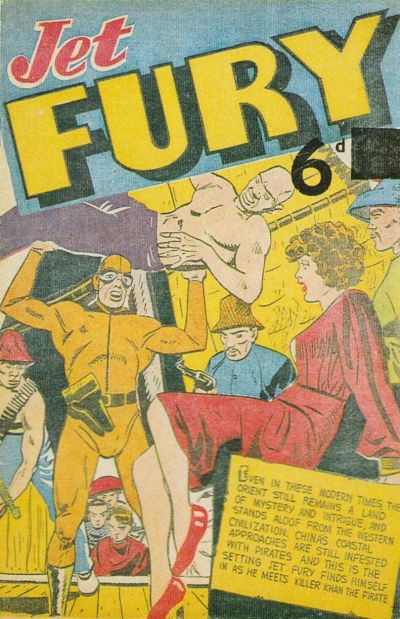
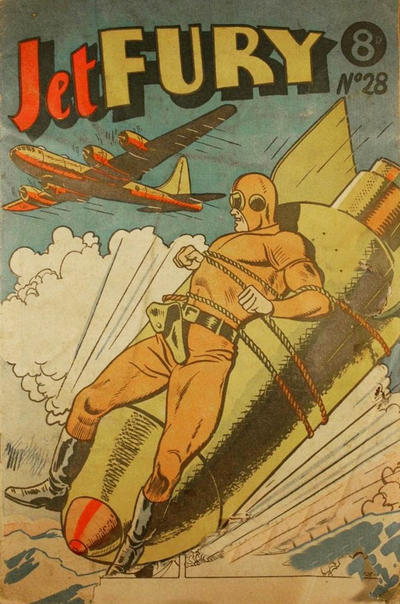
"For Pyramid, Horak created a costumed hero, Jet Fury, who looked like his Skyman character. Jet Fury had originally appeared as a back-up feature in Michael Chance Comics, but soon took over the title and the numbering sequence" -- Ryan, John. Panel by panel. Stanmore, N.S.W. : Cassell Australia, 1979. Page 196.
Publication Dates: 1950 - 1952 Number of Issues Published: 13 (#17 - #29) Color: Colour Cover; Black and White Interior Dimensions: 7.25 " by 10.75" Paper Stock: Newsprint




DavidMcMahon- Cosmic Level
- Posts : 8754
Join date : 2010-05-10
Age : 64
Location : Raleigh, NC, USA
 Re: Superheroes Published between 1951 and 1956 - Dead space between Golden Age and Silver Age
Re: Superheroes Published between 1951 and 1956 - Dead space between Golden Age and Silver Age
The Mask: The Man of Many Faces http://www.internationalhero.co.uk/a/ausmask.htm

The banning was due to the fact that a full face mask was considered a mark of evil in Queensland.

The banning was due to the fact that a full face mask was considered a mark of evil in Queensland.
| Clifton Hill, [Vic.] : Atlas Publications, [1954] 3 volumes : chiefly illustrations ; 25 cm |
| John Ryan Comic Collection (Specific issues). McGee Comics Collection (Specific issues). |
| "Atlas published Horak's "The Mask - The Man of Many Faces" early in 1954. The mysterious figure that emerged from nowhere to strike fear into the hearts of criminals only lasted a handful of issues. It was banned in Queensland at the same time as The Lone Avenger" -- Ryan, John. Panel by panel. Stanmore, N.S.W. : Cassell Australia, 1979. Page 206. |

DavidMcMahon- Cosmic Level
- Posts : 8754
Join date : 2010-05-10
Age : 64
Location : Raleigh, NC, USA
 Re: Superheroes Published between 1951 and 1956 - Dead space between Golden Age and Silver Age
Re: Superheroes Published between 1951 and 1956 - Dead space between Golden Age and Silver Age
Cometman - http://www.internationalhero.co.uk/c/cometman.htm
he was in at least 3 issues. Has no problem killing criminals if those criminals killed innocents.

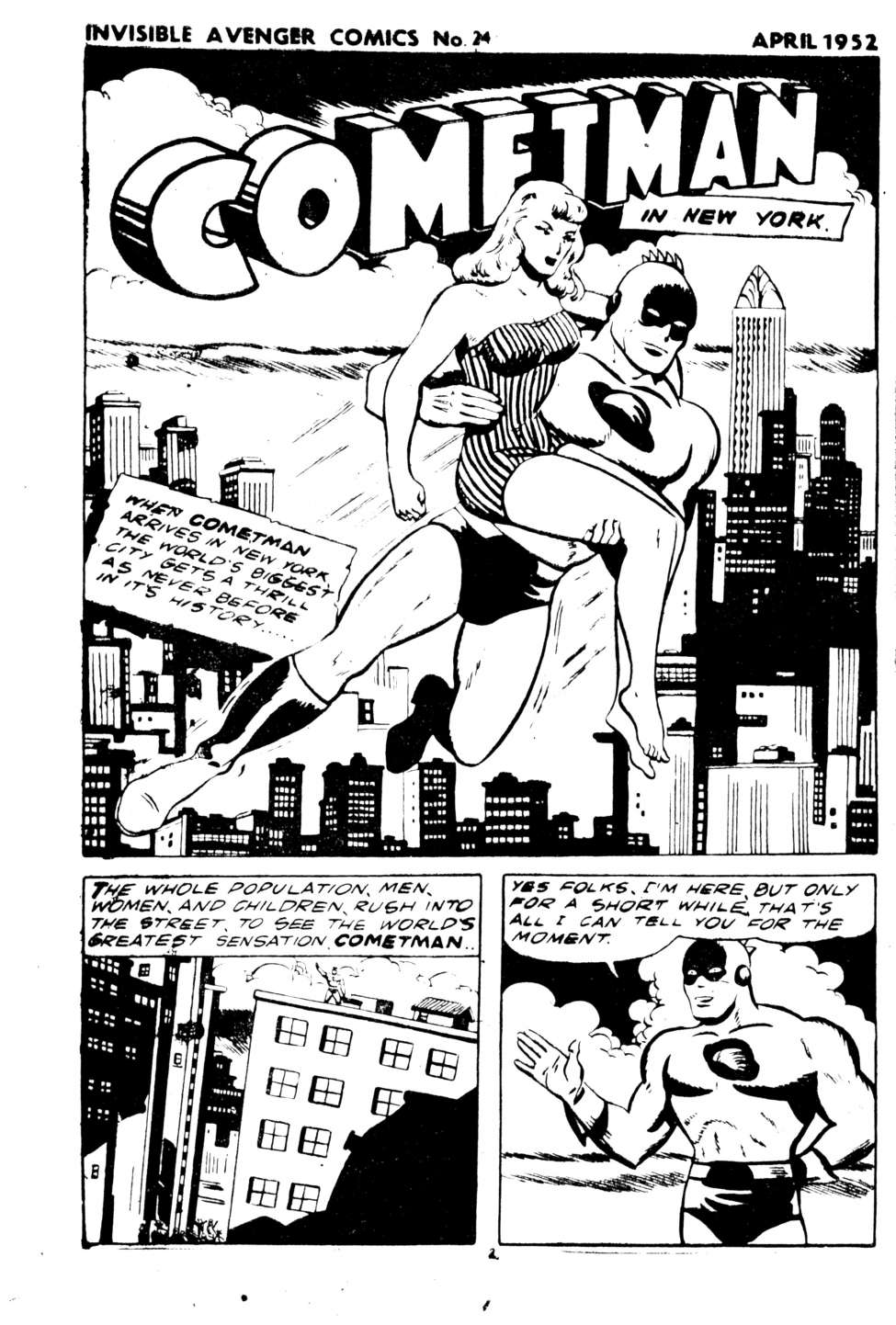

he was in at least 3 issues. Has no problem killing criminals if those criminals killed innocents.




DavidMcMahon- Cosmic Level
- Posts : 8754
Join date : 2010-05-10
Age : 64
Location : Raleigh, NC, USA
 Similar topics
Similar topics» Silver Sentinel
» Kid Kinetic and the Space Knights Issue #3 - Running for Home...
» Magic Golden Age Heroes
» Golden Age Heroes and Villains not magical
» DC Stats for Golden Age characters from writeups.org
» Kid Kinetic and the Space Knights Issue #3 - Running for Home...
» Magic Golden Age Heroes
» Golden Age Heroes and Villains not magical
» DC Stats for Golden Age characters from writeups.org
The Vanguard Play by Post Roleplaying Game :: The Vanguard and Ultrahumans! :: OOC (Out of character chat)
Page 1 of 1
Permissions in this forum:
You cannot reply to topics in this forum
